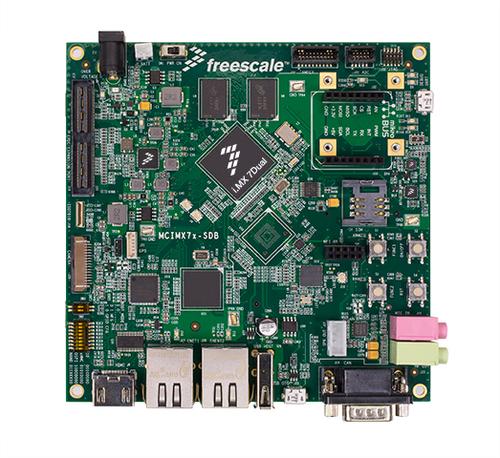PORTLAND, Ore. — Application processors are
the beating heart of the Internet of Things — from industrial
controllers to handheld tablets to the new emerging legions of
wearables. And with all the myriad functions performed by modern devices
there was a gaping need for heterogeneous application processors that
combined high-speed microprocessors with low-power microcontrollers,
both of which could be turned on and off at will depending on the
current function being performed. Freescale Semiconductor Inc. (Austin,
Texas) claims to have pulled off just such a heterogenous mix for
embedded designs with its long-rumored, but finally here, i.MX 7 series
of application processors.
"Freescale is not the first to come out with heterogeneous
processors — TI has done it for their OMAP [Open Multimedia Applications
Platform] for mobile applications — but Freescale is the first to do it
for embedded applications," Jim McGregor, founder and principal analyst
at TIRIAS Research (Phoenix, Arizona) told EE Times in advance of
Freescale's i.MX 7 announcement. "Freescale is taking a dual strategy,
improving their 32-bit line with this announcement, which is smart,
because most embedded applications do not need 64-bit processing.
However, they are also planning to introduce full 64-bit processors,
probably in their i.MX 8 processors, which may come out later this
year."The i.MX 7 is heterogeneous, because if houses either a single, or dual ARM Cortex-A7 high-performance (gigaHertz) microprocessor cores along with a single 288-megaHertzCortex-M4 micro-controller core (delivering 100 microWatt per megaHertz and 70 microWatt per megaHertz respectively). All of the cores can be individually power enabled to perform together or separately as needed. This and several other on-chip domains all of which can be switched on or off separately enable the i.MX 7 to burn the absolute minimum amount of power necessary to perform the currently running job. "The i.MX 7 series we're announcing today combines gigaHertz-class high-performance ARM Cortex-A7 cores with a low-power Cortex-M4 core, which together with our PF3000 power management chip meets the needs of the most innovative Internet of Things [IoT] devices with secure, power efficient industrial, handheld, wearable and new types of IoT innovations inventors haven't even thought of yet," Ron Martino, Vice President of Applications Processors and Advanced Technology Adoption for Freescale’s MCU group told EE Times in advance of the announcement at the Freescale Technology Forum 2015 (June 22-25, Austin Texas).
The first member of the i.MX 7 series is built with Freescale's 28 nanometer process, which has proven to be reliable, ultra low leakage, low power architecture that Martino claimed represents a 48 percent power savings versus its competition while in Low Power State Retention (LPSR) mode supporting DDR self-refresh, timer or single-pin wakeup, memory state retention and no need to reboot Linux. Full-power modes can utilize one, two or all three cores simultaneously with the unused cores off. Overall, Marino claimed the i.MX 7 can cut power by over one-third for most applications, thereby extending battery life, compared to other vendor's solutions. Power saving modes include, in order of power — high to low — run, system idle, low power idle, suspend, standby, sleep (LPSR), secure non-volatile storage — SNVS (that shuts down everything except the flash containing the security keys so that tamper protection remains on) and off.

Freescales
long-rumored, but finally here, heterogeneous ARM-based i.MX 7
application processor uses four-times less power than its predecessor,
the iMX6--as little as 250 microAmps at one volt in its Low Power State
Retention mode (LPSR).
(Source: Freescale)
(Source: Freescale)
When devices are idle, but ready for instant power-up to run mode, the i.MX 7 consumes only 250 microAmps, according to Martino and can be awoken by an on-chip timer or a GPIO (general purpose input/output line). The i.MX 7Dual model with dual ARM Cortex-A7 cores also has dual Ethernet gigabit with audio-visual bridging (AVB) support. Both Single- and Dual-A7 models include external memories interfaces for eMMC5.0, LowPower-DDR3 and are available in 19-by-19 or 12-by-12 millimeter packages. Both will be in full production by the fourth quarter of 2015. Samples are available now.

Freescale's
evaluation board houses the i.MX 7Dual application processor, with dual
ARM Cortex-A7 processors plus a Cortex-M4 processors, along with the
PF3000 power management chip which supports multiple one-to-five voltage
outputs, WiFi, Bluetooth Low Energy and more.
(Source: Freescale)
(Source: Freescale)
http://www.eetimes.com/document.asp?doc_id=1326934
No comments:
Post a Comment